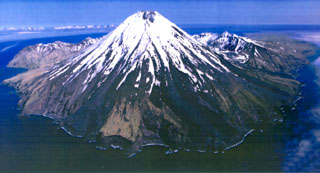Report on Kanaga (United States) — June 1995
Bulletin of the Global Volcanism Network, vol. 20, no. 6 (June 1995)
Managing Editor: Richard Wunderman.
Kanaga (United States) Steaming, weak plumes, and minor ashfall
Please cite this report as:
Global Volcanism Program, 1995. Report on Kanaga (United States) (Wunderman, R., ed.). Bulletin of the Global Volcanism Network, 20:6. Smithsonian Institution. https://doi.org/10.5479/si.GVP.BGVN199506-311110
Kanaga
United States
51.923°N, 177.168°W; summit elev. 1307 m
All times are local (unless otherwise noted)
On 3 and 4 June steaming from the summit and from the 1994 avalanche deposits on the NW flank of Kanaga was observed by US Fish & Wildlife Service (USFWS) personnel. On 19 June a pilot observed a weak plume that rose ~300 m above the summit. He also described possible fresh ash or bare ground due to snow-melt on Kanaga's W side. On 20 June, another aviation report from a USFWS biologist noted a dirty haze or plume at an elevation no higher than the summit, extending ~25 km S from Kanaga. The upper flanks again appeared dark, as on 19 June. An AVHRR satellite image on 21 June showed a steam plume extending ~180 km N, accompanied by a weak thermal anomaly. On 23 June, the U.S. Navy Meteorologic Office in Adak (~33 km E) reported a thin dilute ash cloud rising ~30-60 m above the summit and drifting N. A light dusting of ash on the volcano was noted, and three active steam vents on the S side were observed.
An intermittent, mildly explosive eruption accompanied by lava extrusion within the summit crater occurred at Kanaga Volcano from January through mid-October, 1994. Although summit steam plumes have persisted since then, recent reports suggest renewed, low-level eruptive activity or, alternatively, especially vigorous steaming associated with cooling of lava in the summit crater.
Geological Summary. Symmetrical Kanaga stratovolcano is situated within the Kanaton caldera at the northern tip of Kanaga Island. The caldera rim forms a 760-m-high arcuate ridge south and east of Kanaga; a lake occupies part of the SE caldera floor. The volume of subaerial dacitic tuff is smaller than would typically be associated with caldera collapse, and deposits of a massive submarine debris avalanche associated with edifice collapse extend nearly 30 km to the NNW. Several fresh lava flows from historical or late prehistorical time descend the flanks of Kanaga, in some cases to the sea. Historical eruptions, most of which are poorly documented, have been recorded since 1763. Kanaga is also noted petrologically for ultramafic inclusions within an outcrop of alkaline basalt SW of the volcano. Fumarolic activity occurs in a circular, 200-m-wide, 60-m-deep summit crater and produces vapor plumes sometimes seen on clear days from Adak, 50 km to the east.
Information Contacts: Alaska Volcano Observatory (AVO), a cooperative program of a) U.S. Geological Survey, 4200 University Drive, Anchorage, AK 99508-4667 USA, b) Geophysical Institute, University of Alaska, PO Box 757320, Fairbanks, AK 99775-7320, USA, and c) Alaska Division of Geological & Geophysical Surveys, 794 University Ave., Suite 200, Fairbanks, AK 99709, USA.

